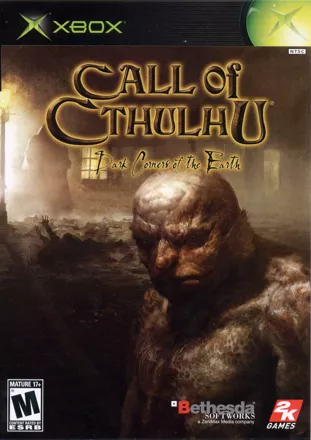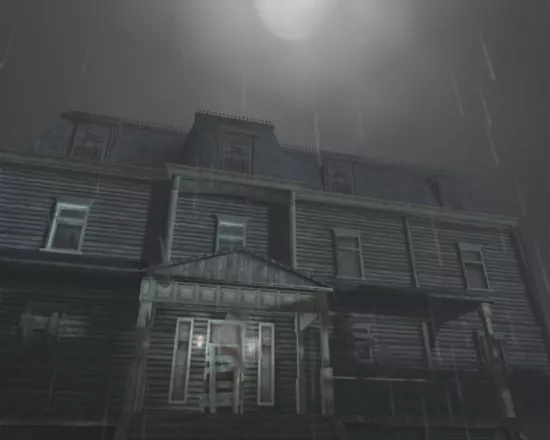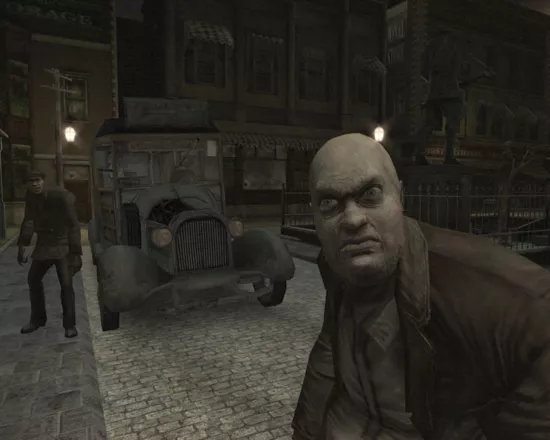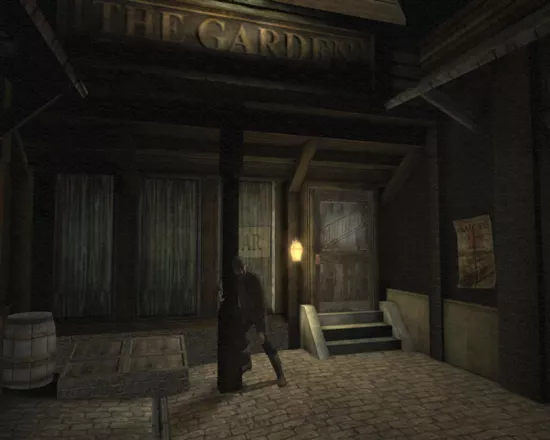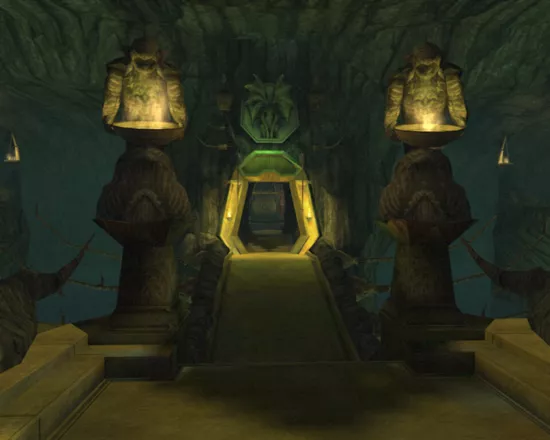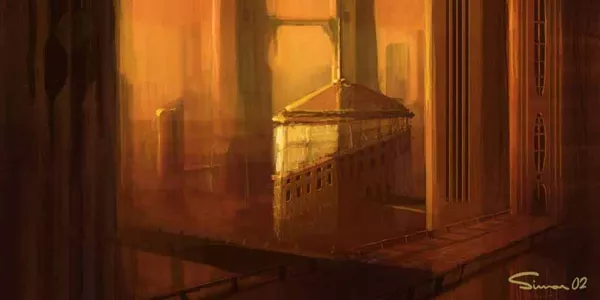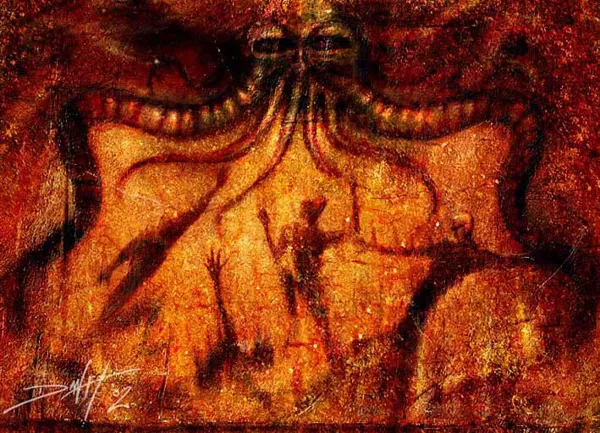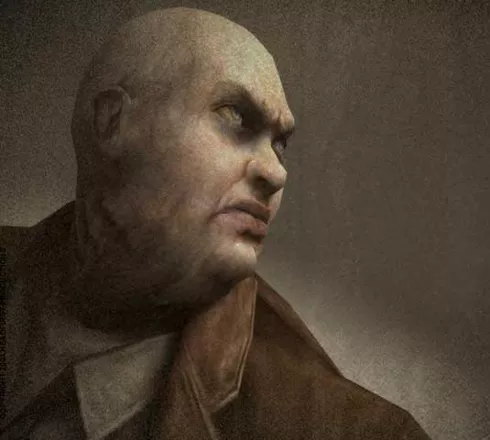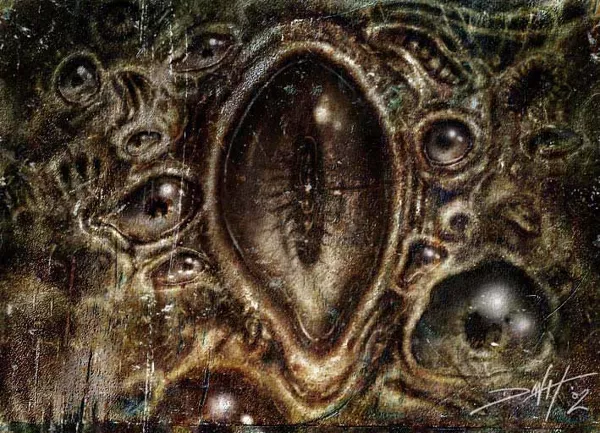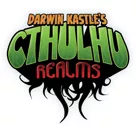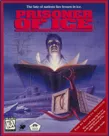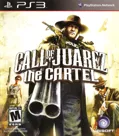Call of Cthulhu: Dark Corners of the Earth
Description official descriptions
Detective Jack Walters arrived in Innsmouth to solve a case of a missing person. But soon he finds himself confronted with terrible mysteries older than humanity, and with ghosts of the mysterious events that led to his incarceration in a mental hospital years ago.
Call of Cthulhu: Dark Corners of the Earth is a first-person action-adventure survival horror game, based on the H.P. Lovecraft mythos and his short story "The Shadow Over Innsmouth".
Initially, CoC: DCotE plays like an adventure game, but soon it gains elements of a stealth game and of a first-person shooter. Notably, the game does not feature an on-screen HUD (not even a crosshair); Jack's health is hinted at by visual cues; as for ammo, you need to remember how much you have left before you'll have to reload.
The health system used in the game is uncommon. There is no "hit points" system; rather, Jack receives minor or major wounds in specific parts of the body, and if he breaks a leg he's slowed down. To heal himself and prevent death from bleeding out, Jack can pick up medikits which contain bandages, splints, sutures and antidotes, each of which is used to heal a specific type of wound. Ill effects emerging from the wounds can be temporarily suppressed with a fix of morphine.
Jack's sanity also plays an important role. When Jack looks at disturbing things or finds himself in alarming conditions, his vision blurs, he begins hearing voices and talking to himself. If this gets too bad, Jack may go insane or commit suicide. Also, Jack suffers from acrophobia, and looking down in high places will cause him vertigo.
Spellings
- 邪神的呼唤:地球黑暗角落 - Chinese spelling (simplified)
Groups +
Screenshots
Promos
Credits (Xbox version)
94 People (91 developers, 3 thanks) · View all
| Producer | |
| Lead Designer | |
| Lead Engineer | |
| Lead Technical Artist | |
| Lead Creative Artist | |
| Lead Animator | |
| Senior Engineers | |
| Engineers | |
| Additional Design & Level Scripters | |
| Technical Art | |
| Background Art | |
| [ full credits ] | |
Reviews
Critics
Average score: 77% (based on 57 ratings)
Players
Average score: 3.8 out of 5 (based on 73 ratings with 7 reviews)
The Good
The story from start to finish is executed very well. There's a lot of stories to uncover and although it doesn't match Lovecraft's writing, for a computer game it's one of the better, if not the best.
The interface without any indicators also helps the game to be more realistic (injury is indicated by blurring of the screen, broken leg by limping, and so on).
Atmosphere is very dense and scary, escalated by creepy sounds and occasional but very fitting music.
For Czech language version - only texts and subtitles, but very expertly translated with perfect grammar and without lost of meaning.
The Bad
First of all, there's a big bug in some versions of the game (looking at forums it seems like a very common problem) - it is the place where you need to shoot with cannon at mages on the Devil's Reef. The problem is that you can't see them so you don't know where to shoot. There's three solutions to this: 1) Patch - The official patch is non-existent and fan-made unfortunately doesn't work for all versions (mine, for example), 2) Search through forums for saved game after this scene but you lose your Statistics, 3) set the sight on the exact coordinates - also can be found on internet (YouTube).
The movement and control is a little clumsy. There is no run, only walk, so don't count on escaping from any shootouts. The reloading of weapons is not very precise so sometimes you have to push the reload button at least twice. Auto-reload would be better solution I think.
There are different ending according to the Grade you receive (taking in account several Statistics), if you don't have a Grade good enough you will only see a shortened version of the outro. Not a good idea.
The Bottom Line
Call of Cthulhu can be described as an action adventure, or better - action game with adventure bits. You take the role of Jack Walters, a private detective who is hired by a store owner to investigate a case of missing employee of grocery store in Innsmouth (a village regarded as haunted by many). The story comes from a board game (which I'm not familiar) with. It's a mixture of several better known works of H.P. Lovecraft, most notably The Shadow over Innsmouth but also including events, creatures and references from short stories and novellas Call of Cthulhu, The Shadow Out of Time and At the Mountains of Madness. All of them recommeded read after finishing the game.
Not including the scary prelude of the game (I don't want to give out any spoilers), you start in Innsmouth, a dark town with unfriendly faces all around. You don't need to be a genius to know that they don't like strangers around there. Your first steps are to look for whereabouts of the missing person, but during your search, you'll made a great deal of horrifying revelations. The game changes from adventure, to stealth, to action very rapidly and there won't be many friends to help you. Eventually you pick up a variety of weapons to defend yourself and you have to decide which is better - to sneak by enemies, to fight them or to run away. New clues and events will be added into your diary but not until the very end you will be able to understand what's going on (and maybe not even after that, see column The Bad).
On inventory screen you will see everything you need - the items, ammunition, diary, medicaments and health. There's more than one type of injury - some lighter ones will heal itself eventually, some you must heal, broken bone must be fixed with split, poisoning must be treated with antidote. Injuries can be healed manually by picking the places to heal or automatically by clicking the button. Healing process itself takes a few seconds when you can't move so better hide yourself before you use it. You must also look after your psychical health, it means if you encounter too many scary events in quick succession, you start to feel dizzy, mumble to yourself and in the end commit suicide.
Looking at items and operating them is done by Use button. Using items in inventory on something is very easy, just by clicking at them, there is no combining of the items in inventory.
For the shooting there are two modes - quick shot and aimed shot, the latter being recommended as there is no crosshair to aim at. But don't aim too long or your hands begins to shake.
At last I recommend to play only at night because the game is VERY dark and the atmosphere and horror is greatly increased.
Overall Call of Cthulhu: Dark Corners of the Earth is an enjoyable game that is moderately long and can absorb you for a few weeks with a lot to think about during that time.
Windows · by Sun King (1555) · 2016
One of a kind; deeply innovative; scary as hell.
The Good
I'm scrambling along the wall of a warehouse while the yokels inside are blasting away blindly, shooting out the windows above my head and showering me with glass. Diving into cover and applying bandages to stop the bleeding from grazing shotgun pellets. Miraculously, none of my bones were broken after jumping off the loading ramp and out the window.
I am Jack Walters, and I really feel like all of Innsmouth wants me dead.
Of course, I know it's all in vain, ultimately: I've seen Jack die, hanging himself in an insane asylum some time from now. But yet I want to find out how it came to be, to see it through to the end. And that pretty much sums up how Dark Corners of the Earth does a better job than practically any other Lovecraft-themed derivatives at being Lovecraftian — there really is a feeling of being powerless, naked and afraid in the face of unspeakable horrors, and yet crawling along as best you can.
The thing that emphasizes this nakedness the most is the HUD: there isn't one. In fact, this game makes the very notion of a heads-up display seem downright ridiculous, like a remnant of 80's arcade machines. Instead of cute little icons telling you that You Have Activated Sneak Mode, the visual field broadens to give the impression of heightened wariness: when you're near death from blood loss, color drains from the world.
The game consistently never mentions 'hit points', only blood loss. If you caught the early marketing hype, you may have been given the impression that the simulationism went one step too far, with your character being able to catch pneumonia. That didn't make the final cut, probably for the better. Instead, the game implements localized damage to the head, torso, arms and legs. Locations can suffer heavy or light bleeding, poisoning, or broken limbs; different wounds require different medical treatments. This has tactical implications, as for example heavy bleeding requires the short-in-supply sutures, deterring you from getting too close to shotgun wielders. (To make sure the game is still playable, Jack has the metabolism of a hummingbird; he'll heal within a minute if all wounds have been treated, however untreated poisoning will kill him within four.)
It's also true to the Call of Cthulhu tabletop roleplaying system in that fighting is fast and deadly. Don't expect your "circle-strafing" skills to be much use, you need to concentrate on shooting abominations in the head before they can reload. That is, if you have a gun.
...you don't have a gun. You were, after all, just going to a quiet backwater fishing village to investigate a missing grocery store clerk. And no, there aren't guns just lying around for you to pick up. Those things are dangerous. What do you think this is, some sort of game? Nor are you in possession of Garrett's ability to magically fade into the shadows; you're just a private dick caught unaware.
See, calling this game "survival horror" gives people the entirely wrong impression: it's come to denote a very particular style of gameplay, to the point where a game like Disaster Report, which is not a horror game, gets called "survival horror." That's not Dark Corners of the Earth; it's inventive to the point of practically being a genre of one. There really is little today that resembles it — the easiest comparison would probably be to Alone in the Dark of 14 years past, and that is again largely because of the general feeling of style and genuine frights.
This style is evident from the very beginning of the game: when the first cutscene ends, you may not realize it, the transition is so subtle. Walking along, you can sense Jack's footsteps. No, not "head bob," his footsteps. Go into the house and in the door on your left. Peer into the darkness. "It's too dark to see anything, but from the rotting smell, it's probably a food store," Jack tells you. Outstanding. There should be (darkened) demo booths of that intro sequence, it'd probably make it up in shifted units.
All of this inventiveness goes towards lending the game gravity, making you forget that you're playing a game. You know, immersion. That thing games are supposed to be all about. This holds true to such a degree that at one point, going back to try and make it through a section with more medical supplies felt like I was violating the story. It happened that I had been scoping out an area and just happened to look up, and— well, that would be spoiling it. Suffice to say, things that would just be "look, scary thing" in a less inspired game are lovingly crafted in Dark Corners to sneak up on you when you least expect it.
Oh, and the music: you don't notice it. You only notice what it does to you. It's brilliant.
The Bad
This game is meant to be played in the dark, and they mean it. Fiddling with the brightness will give you a genuine feeling, when appropriate, of stumbling about in a darkness where things are vaguely sensed rather than seen. This also means that you simply can't play during the day.
Looking at the minimum specs, you might think this game was outdated long ago; that's more of an artifact of the game's long development history, but yes, the graphics are a bit two-years-ago. However, it puts newer graphics cards to work on dynamic lightning, subtle visual enhancement and the effects that give the impression of being groggy when you've just woken up, queasy when in a room with a corpse, scared out of your wits or high on morphine.
There's little point in running the game at higher resolutions than 800x600; you're better advised to spend the horsepower on antialiasing instead. The thing is, and I realize this is a cliché, it moves beautifully. I could spend all day, or rather all night, looking at that old geezer in the poorhouse as he gazes out the window. Half-Life 2 might have super-detailomatic ReActor(tm) technology or whatever; in Dark Corners of the Earth you're talking to people—really talking with them—who are brought to life within the story.
Okay. In all honesty, there is one thing that detracts from the game later on: dead bodies simply fade into the air. If there was one thing about the game I could change, that would be first on the list.
The Bottom Line
Look a couple of paragraphs above. "Queasy when in a room with a corpse." Have you seen that in any other game? Is there anywhere else you've played a character with enough humanity to actually be a bit dizzy in the face of death?
You need to play Dark Corners to see that a game can do things previously unthought of. And you need to play Dark Corners to be Jack Walters, scurrying along the streets and rooftops of Innsmouth, trying desperately to stay alive.
Windows · by Ola Sverre Bauge (237) · 2006
The Good
It happens with many games that there is a big difference between the initial project and the final result. The "Dark Corners" game is a very sad example of this. The difference is so huge that the vision and the final version of the game are going to be my "The Good" and "The Bad" of this review.
We go back in time many, many years from now. I don't remember the exact year, but I think it was probably 2001. The guys from Headfirst present the idea of making a game or a series of games based on the Cthulhu Mythos. It wasn't to be the first one based on the Mythos, but they had a lot of new ideas about how to design a horror game. The main idea was to simulate the hypothetical feelings of the character and transmit them to the player. In addition to these, there wasn't going to be any HUD (to add realism), and the damage on the character would affect him depending on the hit point.
To show all these ideas they made some concept videos that you can probably find in the web if you search a bit. Those videos were pretty revealing. We could watch the character losing his lamp into a pit when scared by the shadow of a monster, accelerating his breath after facing a corpse, having hallucinations where a companion transforms into some monster, etc. And there were more interesting ideas like having to look the barrel of your pistol to see how many bullets you have or cutting a bridge to stop your enemies or block a door with a chest and the feeling that everything was interactive. In addition to all this, there were more interesting and original ideas. I remember reading about the character suffering from vertigo, catching a cold when getting wet, limping when shot in a leg or having bad aim when shot in an arm and probably something more I'm forgetting.
They also add up to the expectation with promises like "you can solve problems in many ways", "you can play twice and it will be completely different", "everything you do will change the course of the story", and so on. They even wanted to make it cooperative, just imagine, a multiplayer not thought as a deathmatch, how many story-following coop multiplayers are out there?, two, three in the history of videogames? Considering that they wanted the game to be an investigation game too this all sounded very well. Obviously, many gamer looked closely to this game.
The Bad
Well, first of, remember never to buy a game before having played it. If you are still young or haven't played too many videogames you maybe still enjoy them, but with time you will learn that nowadays most of the games are the same and that everything that the marketing guys promise with each new game is a lie. Yes, I'm really pissed off with this game.
Now, about this game.
The story of the "actual horror" this game brings began even before its release date. The multiplayer option was discarded many years ago (too good to be true) and from then on everything went downhill. After some uncertainty on the project, the company obtained the money from Bethesda in May 03 and the project was definitely boosted. Of course, the release date was postponed many times, until they quit trying to do a good game and, finally, October 05 was the date. The game was nearly done by then for the XBox and for PC. But one or two weeks before the release day the PC version was delayed half a year (!!), and exactly the same happened with "Oblivion" (for XBox 360), another game from Bethesda. It's said that the CEO from Bethesda also made hamburgers with his dog for the guys of Microsoft that day.
But, finally (this is the last "finally", I swear), in April (I think) 06, the game was released for PC. Let's try to be schematic now because there is to much to say. The game is painfully linear, every original aspect of the gameplay is wrongly implemented and nearly everything in the game can make the experience annoying.
What they have done with the original ideas they had to improve realism and empathy with the character (Jack Walters) is probably the most disappointing thing. First of all, your character has no body. Remember games like "Project Eden", "F.E.A.R.", "Operation Flashpoint" and many others where, even having first person view, you could see your own body? Was that real! This is not a serious mistake, but it was disappointing for me. But the feature most of the people hate about the realism in this game is the fact that you can't run! They probably implement this to increase the sense of horror in the game, but is surely the most annoying feature of the game. You have 4 speeds: "walking" (slow), "crouching" (very slow), "sneaking" (desperately slow), "sneaking & crouching" ("somebody shoot me" slow). You will learn avoiding the last two very quickly, but the programmers seem to want you to suffer. You know, when some marketing guy says "you can confront problems in many ways", it means you can kill your enemies or sneak through them. Well, this game fulfills this fact with the addition that you wont have weapons in some parts of the game, which will force you to go move in this "de facto" slow-motion. At least, this game is really easy as a shooter, so, as soon as you get a weapon, you will need to sneak no more. Most of time, I have just stay there in front of my enemies aiming to their heads to kill them in one (or two) shot, is pretty easy. Yes, the game has more difficult modes, but you can't play them until you finish on the easier mode, and only a loony would play this game twice.
About the physical health system. You have a like a health menu, where you can see the body of your character with all the wounds he has at the moment, which look always the same and are always in the same place. In addition to this, you have a table with 6 parts of the body (there is only 6 hit points) and their state, and all the medical stuff you carry. There are 4 types of wounds, light, heavy, broken bone and poisoned and you have all you need to heal them in a medikit. The poison is something very rare, as there is only one kind of enemy that poisons you, and it appears twice in the whole game. There is a different object to heal each type of wound and in each medikit you find there is a different amount of each. You will always have antidote as you never use it for anything else, so the poison feature is pretty forgettable. When you get hit in the legs or fall, you walk (even) slower and you can't jump and if you are hit in an arm, I think your aim get worse, but I didn't notice it really. If you lose to much blood I think the screen went black and white and previously, after severely wounded, your breath go faster. It sounds fancy, but it is not, really. If you have no weapons and you are hit in a leg, you are as sure as dead, if you have weapons, the praxis is like this. You go around killing enemies, if you are hit, you stop moving, kill all the nearby enemies and heal. If you breath to fast (or was it your heartbeat?), there is some risk for you to die, but not too much. The different ways of healing can be replaced by the "healing button", and, as the first gets annoying very quickly, you'll use the healing button. So, it reduces fast to pushing a button, the fast breathing is nothing new and the limping is just a slow motion. And you don't get cold at all.
About the psychic health system. All the promises of a complex sanity system reduce to two: you can go insane, you suffer from vertigo. The first one goes like this. There are certain scenes that will scare you, most of them involving corpses or limbs, and the big bosses scare you, but you wont be scare by nothing else, no matter if you are surrounded by enemies or in a very bizarre place, it's only about corpses (and stuff) and big bosses. If you get too scared by something, the heartbeat accelerates and the screen waves, then you suffer a mental collapse and the game just ends. When the screen begins to wave, is usually impossible to get sane again. The silly thing is that only big bosses can make your mind to collapse, as the creepy scenes are only some seconds and they are usually programmed so you can avoid them, but, if you avoid the creepy scenes, what are you playing this game for? So, that's how you play this aspect of the game: you try to watch all the creepy things you can (it doesn't matter anyway) and when you go crazy fighting a big boss even when you weren't doing nothing different from other times, you just reload the game for the fifteenth time to save some time. And, instead of hallucinations Jack has "visions" from the very eyes of his enemies. These are programmed to happens as intros loaded at certain points of each level, in a completely deterministic way. When you pass through certain point of a map you watch a vision, always the same vision. It is suppose to give you advantage on your enemies or just help to the mood of mystery and horror. And yet, it gets annoying. It happens that these visions can't be skipped, so, when you get stuck at some point of the game (something frequent) and there is a vision in at this point, you are going to have to fully watch this vision every time you reload. The intros are skippable, but the visions, for some reason, not.
And the vertigo feature gets also annoying! It works like this. If your are 4+ meter high and look down near an edge, the screen goes blurry. It basically means that you can't jump from platform to platform looking down, and this is pretty difficult in FPS games. And it has nothing to do with your sanity status at all, the guy just has vertigo. It's not a big deal, but there are some levels in the first part of the game where there are very narrow platforms involved, which you will need to repeat many times. The vertigo feature is another feature that makes the game more annoying than fun.
You'll notice very soon too that the game is very linear. So linear that you'll have all the time that sensation that everything waits for you to happen. Even when you meet NPCs, there is only one conversation possible, even when the scenario is wide and with multiple paths you will have a strict script to follow, even when you can or have to go back nothing new will happen unless you have made what you have to. Seriously, sometimes when you don't do what you are suppose to do, the game reacts stupidly forcing you to load a previous game. There is a place, for example, where you have to follow a straight path and climb some creeper at the end. But, a couple of "big boss" kind of monster appear when you reach this plant. Well, if you try to run away up the creeper, the character falls and say "I can't get out until I kill them", no matter if your sanity is high or low or if anybody in the world would run the hell out of there, you just have to kill them. In fact, the bosses in this game are highly scripted forcing you to play each usually 20+ times until you find that concrete action you must perform to defeat them. For example, there is a big boss that block the path with a tentacle, which also uses to hit you. You can't pass through until you do certain thing. Well, if you try when the tentacle is hitting you, it just appears in front in a realistic speed, because you MUST follow the one and only script.
And if all of this were not enough, the game has a plague of bugs. Probably one of the main reasons is the mentioned linearity of the game, the script of the game is so closed shut, that every time the player does something unexpected (and the programmers have very little "expectations" on the player) the script can just fail and you need to reload a previous game. But there are of all kind. Remember the scene with the creeper from the previous paragraph?, well, after trying many times to kill these annoying monsters I found myself stuck there because the game "didn't know" that I had kill these two monsters. And there are also some intros that you can only hear because the video doesn't load correctly. And I want you to remember that this game was released half a year after the version for the XBox, and they have done nothing about the bugs! After laughing at us delaying the PC version unnecessarily. But the funniest thing with this game comes at the end. Yes, I'm going to spoil it, if you still are going to play this game (no, seriously), avoid this part.
It happens that the final level of this game is about Jack escaping form an underwater temple that is falling apart. Of course, there is only one path to follow, and yes, the character escapes walking!!, how silly is that? This is especially exasperating because there is a really random bug in this level: when you reach a tunnel nearly at the end of the level, suddenly, everything collapses and you die, just like that. The level is so easy that you could do it at the first time, but, instead, you have to repeat nearly the whole level for a random number of times (it took me 6 times, but it can be much more) and you must do it walking!! And the final video can be buggy, too!!, and you can only watch this video if you repeat all the level again to see if you have luck this time. But that means another random times the last level!! I didn't even finish the game technically nor watch the final video!!, I hate this game!, it's horrible!!
The Bottom Line
The collapse of the FPS games reaches its climax in this game. Everything that can be done wrong, and, especially, that can be done annoying, in a professional FPS is in this game: constant loads in too hard levels, an offensive linearity, too many scripting, uncreative levels, hundreds of boxes, exasperating bugs, sneaking oriented situations that nobody enjoys, very unrealistic movements and a character with no body, unchallenging shooting, adventure aspects that add very little to the game, etc. The promise of a new concept of horror game, where realistic behavior of the main character and the simulation of his feeling were an important part of the game, and the very common idea (that never prospers) of "every interaction with the world will make a difference" when projecting games, has become into a great failure.
Seriously, games are suppose to be fun, not to feel frustration all the time. And it's even more frustrating when you wait for a game for years and everything that has been promised is a big fat lie. Will they learn something for the next games in the series or will they just do the minimum to make some money? Learned lesson: Never give your love to a videogame project, :)
Windows · by MichaelPalin (1414) · 2006
Trivia
Details
When playing Call of Cthulhu: Dark Corners of the Earth pay close attention to your surroundings, especially during the first hour or so of playing. Look on rooftops, peek through the occasional cellar window and so on. There are a lot of little "details" in the environments and you might catch a glimpse of something you didn't expect, and it might even be a bit disturbing. These can range from quick glimpses of some inhuman horror as it passes by a window to seeing a dead body that's been hanging from the ceiling for weeks.
Development
The March 27, 2006 release date of the PC version ended a six-year cycle of development hell. Headfirst began developing Dark Corners of the Earth for a German publisher named Fishtank. Fishtank was taken over by JoWood and JoWood wasn't interested in the title. Headfirst continued development while searching for publishers. Bethesda ended up with the publishing rights, but they wanted it as an Xbox title, not a PC game.
The Xbox version was released in October of 2005. Shortly after that, Headfirst entered into financial difficulties which affected their ability to pay their employees, leaving many of them to find employment elsewhere. Headfirst was forced to sell their Simon the Sorcerer license to Silver Style and put their offices up for sale. The remaining Headfirst employees completed the port of Dark Corners of the Earth. As of 2006, plans for additional Call of Cthulhu games, Destiny's End and Beyond the Mountains of Madness seem to be dead.
German version
The Xbox version (when having the console set to German) misses all blood effects when hurting enemies. All other blood effects are untouched.
References
Take a look at the posters of Brian Burnham, which are scattered through the game, on these he has a striking resemblance to H.P. Lovecraft.
Usenet
The development of Dark Corners of the Earth can be traced back to a 1999 Usenet post where Headfirst's Andrew Brazier asked alt.horror.cthulhu readers, "What would you want to see in a Cthulh (sic) computer game ?"
Awards
- GameSpy
- 2006 – Level of the Year (PC) (for Hotel Escape)
Information also contributed by MasterMegid and Robstein
Analytics
Upgrade to MobyPro to view research rankings!
Related Sites +
-
Official Site
Official Site for Call of Cthulhu: Dark Corners of the Earth
Identifiers +
Contribute
Are you familiar with this game? Help document and preserve this entry in video game history! If your contribution is approved, you will earn points and be credited as a contributor.
Contributors to this Entry
Game added by Dwango.
Windows added by Kabushi.
Additional contributors: Terrence Bosky, Unicorn Lynx, n][rvana, Alaka, UV, Eltahriel, Patrick Bregger.
Game added January 23, 2006. Last modified March 15, 2024.
